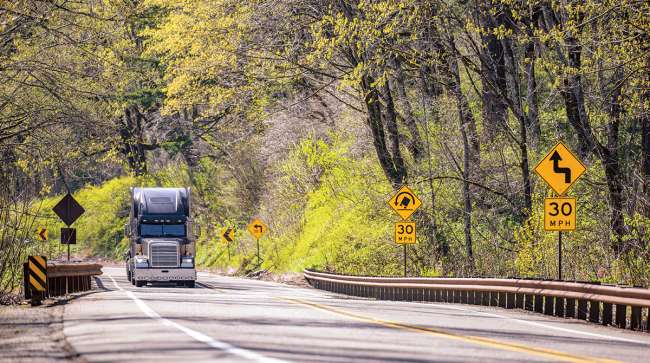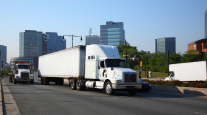Special to Transport Topics
Traffic Eases Amid Pandemic, but Trucking Insurance Costs Still on Upward Trajectory

[Stay on top of transportation news: Get TTNews in your inbox.]
Reduced highway traffic during the ongoing COVID-19 crisis has lowered the risk of crashes, but this silver lining of the pandemic has provided only a temporary reprieve for trucking companies that have seen escalating insurance costs in recent years.
When the coronavirus outbreak first took hold in North America, miles traveled by the general public on the nation’s highways plummeted in the spring and early summer.
Much of the trucking industry saw miles drop, too, reducing exposure. For many fleets, slack demand during the early days of the pandemic meant more trucks parked against the fence, more drivers on furlough and fewer vehicles to insure.
Accident rates decreased as congestion declined, and truckers were able to reach their destinations with far fewer traffic-related delays.
While those conditions did temporarily reduce the risk of crashes, trucking insurance experts said the broader landscape for insurance and risk management in the commercial transportation industry has not changed permanently.
“We saw ... a definite decrease in April and May in reportable frequency of accidents due to [less] traffic on the road and not nearly as much congestion. But that has normalized into the fall,” said Matt Payne, senior vice president and transportation team leader at Kansas City, Mo.-based insurance brokerage firm Lockton Cos.
Less traffic in congested “hot spots” known for higher accident rates has been a positive, said Greg Feary, president and managing partner of Scopelitis, a transportation law and insurance firm with about 5,000 transportation-related clients in the United States.
“In densely populated urban areas ... you could make an argument that COVID-19 has created a better delivery environment because it’s easier to get in and out [of those areas],” Feary observed. “Everything from serious accidents [to] fender benders has been reduced.”
Yet overall, Feary does not think that the pandemic has changed the trajectory of the insurance market very much, noting that it has been trending toward higher costs for some time due to a variety of issues not related to the coronavirus.
“It’s kind of a blip in time,” he said of the pandemic’s effect on risk exposure for truck lines. Whereas in the consumer vehicle insurance markets, some carriers have provided rebates to motorists, that’s not been the case in commercial trucking.
Greg Orr, president of Joplin, Mo.-based truckload carrier CFI, agreed with Feary and others that the pandemic created a short window where “we did see fewer cars on the roadways, which was helpful to truck drivers, who had to deal with less traffic and congestion — and fewer accidents.”
Meanwhile, professional truck drivers received an outpouring of public recognition from a nation coping with a once-in-a-century pandemic. Orr cited “random acts of kindness” as people went out of their way to show their gratitude for truckers and the work they do. He’s had drivers share stories of motorists approaching CFI drivers at rest areas, fuel islands and parking lots after making a delivery, and thanking them for keeping goods moving. One driver came back to his rig to find a bouquet of flowers and a card on the running board.
“That part has been inspiring,” Orr said. “The pandemic has helped the reputation of the overall industry as many Americans are finally realizing the necessity of trucking to their daily lives.”
The Rise of Nuclear Verdicts
Although the pandemic briefly eased traffic congestion and the risk of crashes in the short term, several longer lasting trends have been driving up insurance rates and premiums in the past several years.
One key factor contributing to trucking’s increasingly challenging insurance market is the proliferation of “nuclear” verdicts — judgments of $10 million or higher awarded in cases involving truck crashes.
Nick Saeger, associate vice president for pricing and underwriting at Stevens Point, Wis.-based Sentry Insurance, said “social inflation” is contributing to the growth of these high-dollar awards as plaintiffs’ attorneys seek to play on the jurors’ emotions to drive the verdict, regardless of the facts.
In practice, plaintiffs’ attorneys are trying to reach the “reptilian” part of the jurors’ brains, which instinctively wants to protect family and community from danger — and do so through their verdict. The strategy does not necessarily focus on fault or facts. Its calling card is fear and revulsion, and convincing juries to hand down verdicts intended to punish the defendant trucking firm and send a message to the industry.
At the same time, plaintiffs’ attorneys are more aggressively targeting the trucking industry.
“They are getting out of mass tort [and] into personal auto [and truck] claims,” where they hope to get awards faster, Saeger said.

mladenbalinovac/Getty Images
As part of this trend, attorneys are conducting deep research into trucking company history, operations, practices, procedures and documentation, seeking evidence to support claims of institutional negligence or bad practices that could allegedly contribute to poor safety and cause accidents.
Litigation financing is another key trend, Saeger said. In some cases, a plaintiff’s attorneys may not have the financial resources to pursue what can be lengthy litigation all the way to the finish line, which could be years away. But investors, such as hedge funds, seeing the prospect of a financial windfall, will finance the attorney’s expenses on the case in return for a cut of a settlement or verdict award.
“We know that this is happening,” Saeger said.
Trucking defense attorney Doug Marcello, a partner at Carlisle, Pa.-based Marcello & Kivisto, has seen firsthand the dramatic rise in aggressive law firms promoting themselves as specialists in trucking liability litigators.
With medical malpractice reforms lessening the prospect of big paydays in that arena, “trucking has become [the] profit center for a lot of plaintiff attorneys,” said Marcello, who, along with his law partner, also has a commercial driver license. “They live by the mantra, ‘Hit a truck, get a check.’ They look at an 18-wheeler as a rolling ATM machine.”
Reducing Risk Amid a Pandemic
While the pandemic did not necessarily create any liabilities thus far that would fall under commercial truck policies, issues related to the coronavirus presented other risk management challenges.
Front and center was obtaining and providing personal protective gear to employees, protecting employees’ health by regularly cleaning and sanitizing trucks and facilities, managing social distancing, and dealing with shippers who no longer wanted drivers walking the dock or performing inside deliveries, chatting with traffic managers and exchanging paper documents. Any COVID-related health claims related to on-the-job activities were more likely to be covered under worker’s compensation policies.
For Pittsburgh-based less-than-truckload carrier Pitt Ohio, being proactive, diligent, and consistent in responding to the pandemic, and focusing on employee safety, has paid dividends, said Jim Fields, the company’s chief operating officer.
At the outset, the company acquired and distributed personal protective equipment to all employees. That was a significant challenge due to short supply, exacerbated by the need for N95 masks to be distributed to hospitals and health care facilities first.
Pitt Ohio mixed and distributed its own hand sanitizer. It also purchased high-volume commercial paint sprayers, using them to regularly disinfect large dock areas, workspaces and trucks. High-efficiency particulate air filters were installed in office heating and air-conditioner systems. Employees’ temperatures were measured before entry at each facility. Trucks were sanitized on the lot, and the day’s bills placed in the cab in advance so drivers could go directly to their trucks without stopping in the office. Most importantly, processes were immediately modified to prevent contact between employees and with customers to maintain social distancing.
“It was critical to keep our workforce healthy in order to service our customers,” Fields said.
As a result, Pitt Ohio has experienced nine positive COVID-19 cases among its more than 3,000 employees, the company said.
“And all of those were contact-traced back to family members who worked at some level in health care,” Fields said.
Pitt Ohio has had zero interruptions due to COVID-19 and has not had to suspend operations or close any terminals.
With respect to the pandemic and its impact on commercial truck insurance costs, Fields echoed the experience of others, noting that the pandemic didn’t really affect Pitt Ohio’s premiums or rates.
The company has formed a “captive” shared-risk insurance plan whose members are all Pitt Ohio subsidiaries, and ultimately can retain some of the business risks through that structure.
Pitt Ohio is ranked No. 45 on the Transport Topics Top 100 list of the largest for-hire carriers in North America.
A Difficult Climate For Trucking Insurance
Given the rise in nuclear verdicts and other factors, it’s been a tough couple of years for insurance companies, so much so that there are fewer providers today willing to write policies for trucking companies — yet another factor in higher premiums as the pool of capacity has shrunk.
While pricing this decade has increased, “the trucking insurance market has not seen a profit in quite some time,” said Chris Homewood, senior vice president and head of commercial auto for New York City-based Hudson Insurance Group. All in, he estimates over the past 10 years, the industry has been paying out between $1.03 to $1.12 per dollar of revenue taken in. That’s not a sustainable business model, he said.
With the total cost and severity of claims on the rise, “we will continue to see less [insurance] capacity, less coverage available,” Homewood said.
That which is available will cost more.
“It is more challenging for [trucking companies] to build out their liability limits ... where they would want to purchase $100 million in limits, they can only get [quotes on] $40 million. So capacity is declining.”
And truckers are being placed in a position of having to buy less coverage for more money.
Homewood added that as fleets adopt more onboard safety technology to proactively alert and assist drivers in avoiding or minimizing crashes, that will help stem the tide of increases. He cited in particular the value of in-cab camera technology, the data it provides, and its supporting software and driver training and behavior management tools.
Cameras and their data enable companies to proactively coach and “educate drivers to change habits,” correcting behaviors before they lead to accidents, Homewood said.
Importantly, in accident liability cases where the trucker is alleged to be at fault, such systems provide irrefutable video evidence that can validate the driver’s innocence and confirm that fault lies with the other party, all of which helps reduce claims expense for truck lines and their insurance carriers.
Risk and its attendant costs, he said, “all boils down to loss exposure and the history of the truck line.”
Underwriters will put together the best policies with the best rates for “those motor carriers who demonstrate a strong culture of safety and accountability, particularly those who have skin in the game with self-insurance retention.”
Nevertheless, Homewood said Hudson still sees opportunity in the market. Last month, the company launched new commercial truck coverage for independent contractors, such as owner-operators running their own trucks. The coverage, offered exclusively through retail brokers in select states, includes occupational accident, contingent liability, truck physical damage and workers’ compensation, as well as nontrucking liability.
What else can fleets do to rein in insurance costs, reduce claims and mitigate rising premiums?
“Focus on owning the risk you can manage,” said Dan Cook, principal and practice leader at True North Cos., one of the three largest insurance brokers for trucking companies. “Motor carriers who manage risk as a key operational activity ... do better than motor carriers who hand off some of that responsibility to the insurance company.”
Cook recommended that fleets collect and monitor data on their operations and establish key performance indicators for safety.
Ultimately, motor carriers can reduce risk and better manage their insurance costs by building a culture of safety and accountability across the entire company, from the CEO and fleet managers to the drivers, dispatchers, dock workers and technicians, he said.
Want more news? Listen to today's daily briefing:
Subscribe: Apple Podcasts | Spotify | Amazon Alexa | Google Assistant | More




